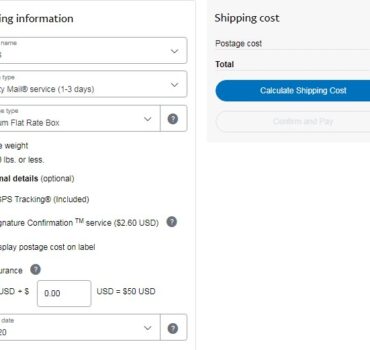Using stamps to send a letter or package can be tricky, but it doesn’t have to be a cause of frustration. In most cases, the number of stamps you need will depend on the size, weight, and class of the item you are shipping.
Once you have this information, connect it to an online price calculator like the one offered by the US Postal Service (https://postcalc.usps.com/) to find out the cost of postage. If you don’t know how much your item weighs, you can always take it to the local post office and have them do the weighing and counting for you.
As of January 2019, the standard first class stamp rate has increased to 55 cents. Depending on what you are sending, you will often wonder if you need one or two stamps. It’s inevitable! However, if you make the mistake of overestimating the postage required to send a letter, you’re essentially throwing money out the window. While that doesn’t seem like much when it comes to “pennies,” those pennies increase over time.
Most letters that weigh less than 30 grams today can be mailed with a first class postage for 55 cents. Adding a second stamp (when you don’t know the true postal rate for your letter), results in a very generous mailing donation. In this article, we’ll discuss other methods you can use to determine the correct postage and make sure your letter arrives safe and sound.
Table of Contents
Weight rules
If you’re sending a 60-cent letter, you’ve obviously exceeded the 30g weight limit rule for a 55-cent stamp. A two-ounce letter costs $ 0.75 to send ($ 0.55 for the first ounce and $ 0.20 for the additional ounce, based on the January 24, 2021 price increase). If you put two 55-cent stamps on a two-ounce letter, you’re paying over $ 1.10 (and you’ll never get that money back). You can imagine how quickly it can increase over time.
How many pages (or pieces of paper) can you Mail with a stamp?
When it comes to how many pages you can send in a 30 gram letter, the answer is usually between four and six sheets of standard paper. Remember that you also need to consider the weight of the envelope. As long as you’re under one ounce (all-in) you will only need a 55-cent stamp. If you use thick paper or larger envelopes, the cost of postage will increase.

If you plan to charge two ounces, you can send ten pages of standard paper with your envelope. If you are unsure of the weight of your envelope, remember that every post office in the United States has a scale. Try out the paper and envelopes you use and take them with you to the post office. Here you can manage different amounts of pages and combinations of envelopes. It’s a sure-fire way to learn how to maximize the effectiveness of your direct mail.
No ladder?
Although the solutions we suggested above work well if you have access to a ladder, what if you don’t? If you are unable to make it to your local post office (due to time constraints, for example), there are other strategies available to find out the weight of your letter.
One way to do this is to understand the way letterhead is traditionally sold. Stationery is available in reams, which means that there are usually five hundred pieces of paper in each ream. Most reams of paper have a weight in the ream. Keep in mind that the weight in the oar can be a bit misleading as it does not refer to the total weight of the package. Instead, the weight informs customers of the total weight of the paper before it is reduced to the size of a letter.
When the letter paper is wrapped, its size is 20 x 27 cm. However, it is standard procedure for manufacturers to weigh stationery while it is still in its 17-inch by 22-inch uncut size. This is how it works:
Each uncut sheet creates four individual sheets when the process is complete. Therefore, the weight you see on a ream of paper is actually four times what you have physically. The most common letter weight you will see is twenty pounds (20 pounds or 20 pounds). This means that a ream of the same type of paper weighs 2.5 kilograms after being cut.
If your head is spinning after reading all of this, trust us, you are not the only one! Obtaining a personal scale will always be the most convenient method of preparing letters / packages for dispatch. However, with the information above, you should be able to determine how to calculate the paper weight if there is a problem (how many stamps to use). It will take some maths (and a lot of patience), but it’s definitely worth it in the long run to hold onto your hard-earned money.
Paper weight calculations
If you can estimate the weight of a ream of paper, you can calculate the weight of an individual sheet of paper (by dividing by five hundred – because there are 500 sheets in a ream). For example, if your ream of # 20 paper physically weighs five pounds, each piece of paper will weigh 0.01 pounds in total. From there, for postal reasons, we want to convert into jaguars.
One pound of weight contains sixteen ounces. If you want to know how much a 20 pound ream sheet weighs, multiply the weight of the individual sheet (0.01 pounds) by sixteen (0.01 × 16 = 0.16). This means that a single leaf would weigh 0.16 ounces.
If you buy photocopying paper frequently, you know that it usually comes in reams of ten pounds. However, if you’re not sure what type of paper you’re using (but it looks like it’s a standard size), you can probably estimate that your paper weighs five physical pounds for every five hundred sheets of paper.
Post estimate
Once you know how much each sheet of paper will weigh, you’ll need to take another step. You will need to multiply this weight by the total number of pieces of paper you plan to use. Therefore, if you have ten sheets of paper and each piece weighs 0.16 ounces, the total paper will weigh 1.6 ounces. Leaving some room for the weight of your envelope means that you will need two 55 cent stamps (as we saw earlier).
Once you know the total weight, you can check and confirm the US Postal Service chart for current rates. With the USPS, you’ll look good with a 55-cent stamp for any letter weighing up to 30 grams.


